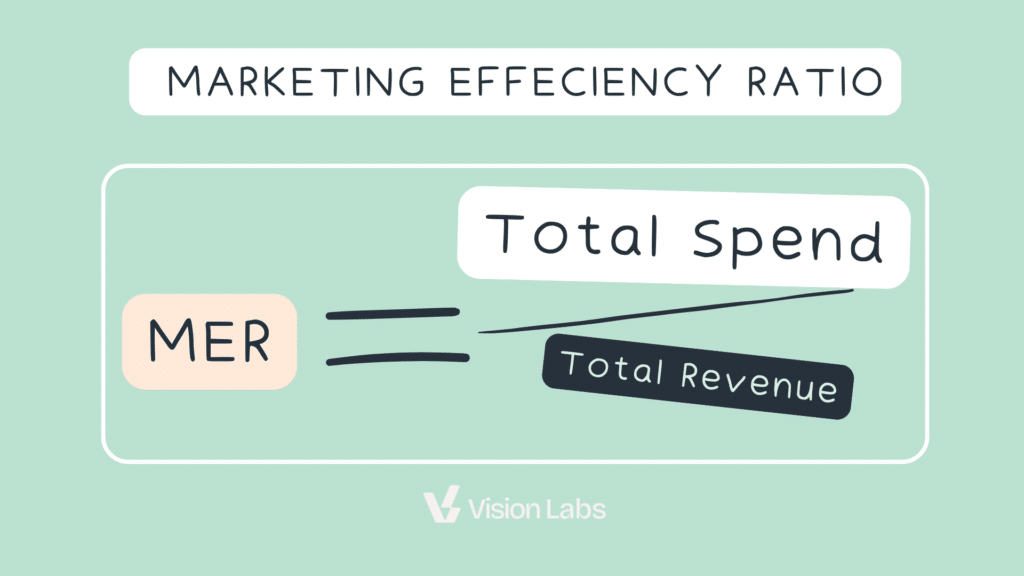Marketing Efficiency Ratio (MER) Calculator
Calculate your MER and aMER with this online calculator. Measure overall marketing performance and new customer acquisition efficiency.
Calculate your Marketing Efficiency ⬇️
How to calculate Marketing Efficiency Ratio (MER)? Formula
Marketing Efficiency Ratio is the total amount spent on marketing divided by the total amount of revenue generated that period.
MER = Total Revenue / Total Marketing Spend
For example, if you earn $23,000 in revenue from $17,000 in marketing, your MER is 1.35, meaning you make $1.35 for every dollar spent

For example, if you earn $23,000 in revenue from $17,000 in marketing, your MER is 1.35, meaning you make $1.35 for every dollar spent
How to Analyze MER & aMER?
MER (Marketing Efficiency Ratio): measures overall marketing performance.
- MER > 1 indicates profitable marketing (e.g., 1.5 means $1.50 total revenue per $1 spent)
- MER < 1 means you’re losing money on overall marketing, taking into account new and returning customers.
aMER (Acquisition Marketing Efficiency Ratio): compares the revenue generated from new customers to the total marketing spend.
- aMER > 1 shows profitable customer acquisition (e.g., 1.2 means $1.20 new customer revenue per $1 spent).
- aMER < 1 suggests unprofitable acquisition strategies.
Remember: MER gives a broad view of marketing success, while aMER zeroes in on new customer costs.
To interpret aMER (Acquisition Marketing Efficiency Ratio), consider the following:
- Compare aMER to MER: If aMER is significantly lower than MER, your profitability relies heavily on repeat customers.
- Consider Customer Lifetime Value: A low aMER might be acceptable if customers have high long-term value.
- Track trends: Monitor how aMER changes over time to assess the effectiveness of your acquisition strategies.
By monitoring MER on a daily basis, you can maintain a close pulse on your overall marketing performance and respond promptly to any shifts in efficiency. This frequent analysis enables you to optimize your marketing efforts continuously and ensure that your marketing spend is consistently generating a positive return on investment. - Use for optimization: Compare aMER across different channels or campaigns to allocate budget more effectively.
What is Marketing Efficiency Ratio (MER) and acquisition Marketing Efficiency Ratio (aMER)?
MER (Marketing Efficiency Ratio) directly shows your marketing investment’s return. It answers: “If I invest X in marketing, how much revenue (Y) will it generate?”
MER doesn’t just measure the efficiency of acquiring new customers, but also how well you’re nurturing and retaining existing ones. This comprehensive view is crucial because returning customers often contribute significantly to overall profitability.
A higher MER indicates a more efficient marketing strategy, where less money is spent to generate more revenue.
aMER (Acquisition Marketing Efficiency Ratio) specifically measures the return on your investment for new customer acquisition. It answers: “If I invest X in marketing, how much revenue (Y) will I generate from new customers only?”
aMER is crucial for understanding the efficiency of your new customer acquisition efforts. It helps you identify whether your targeting, ad creative, or offer needs adjustment.
By tracking aMER alongside MER, you can discern whether your overall marketing profitability is being driven by new acquisitions or by returning customers.
FAQ's
Why is MER important?
MER (Marketing Efficiency Ratio) and aMER (Acquisition Marketing Efficiency Ratio) are crucial metrics for e-commerce businesses for several reasons:
- Clear ROI measure: MER provides a comprehensive view of marketing return on investment, showing how effectively overall marketing spend generates revenue.
- Performance insights: These metrics help gauge the effectiveness of marketing strategies, revealing how well campaigns are performing and where adjustments are needed.
- Efficiency indicators: A high MER indicates successful marketing driving sales, while a low MER may signal inefficiencies requiring reevaluation. aMER specifically highlights the efficiency of new customer acquisition.
- Budget optimization: MER and aMER allow businesses to optimize marketing spend by allocating budget to high-performing channels and campaigns.
- Comprehensive view: MER offers a broader perspective on marketing efficiency compared to metrics like ROAS, as it includes all marketing activities and costs, not just paid advertising.
- Acquisition vs. retention insights: While MER provides an overall picture, aMER specifically focuses on new customer acquisition, allowing businesses to balance their efforts between acquiring and retaining customers.
What are the common mistakes when calculating MER and aMER?
Common mistakes include:
- Not distinguishing between new and returning customer revenue when calculating aMER
- Failing to account for all marketing costs
- Using incorrect time frames (e.g., comparing this month's spend to last month's revenue)
- Not considering seasonal variations or promotional periods
- Overlooking the impact of customer lifetime value when interpreting aMER
What are the best practices for improving MER & aMER?
For New Customers (focusing on aMER):
- Refine targeting: Use data-driven insights to reach potential customers who are more likely to convert, improving the efficiency of new customer acquisition.
- Optimize ad spend for acquisition: Allocate budget to channels and campaigns that show the best performance in acquiring new customers.
- Enhance first-time customer value: Focus on increasing the average order value (AOV) for new customers through product bundles or targeted upsells.
For Returning Customers (contributing to overall MER):
- Optimize marketing for repeat purchases: Allocate part of the marketing budget to encourage existing customers to make additional purchases.
Use automated sequences, personalized recommendations, time-sensitive offers, loyalty programs, and cart reminders to boost customer retention and increase overall MER. - Increase customer lifetime value: Develop strategies to maximize the long-term value of existing customers, which will positively impact overall MER.

JJ Reynolds
JJ Reynolds is the founder of Vision Labs, a white-label data agency specializing in custom measurement systems and real-time marketing dashboards. Having worked with startups to multi-billion dollar companies, he creates bespoke reporting solutions that help businesses turn data into decisions. His expertise in media buying, PPC, and analytics enables companies of all sizes to make smarter, data-driven choices.
All Marketing calculators
Get notified immediately as new calculators & strategies are launched
Join 6,000+ D2C Brands, Marketers, & Analysts who want to act on their data